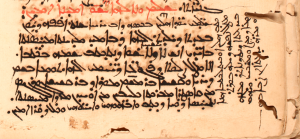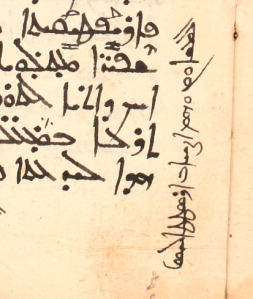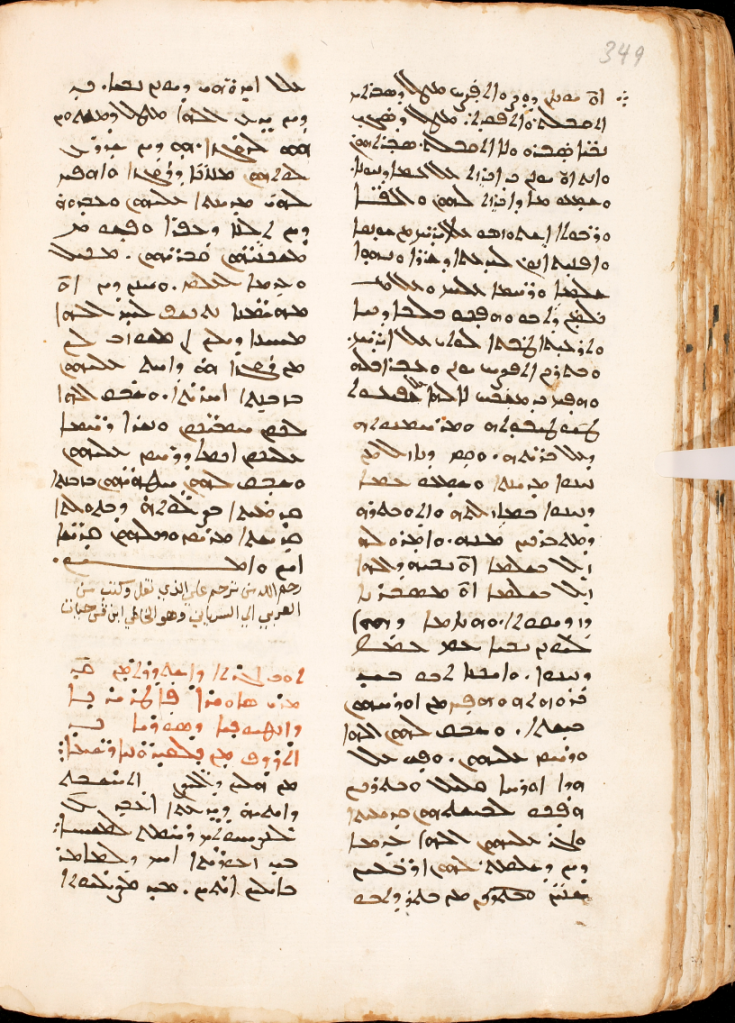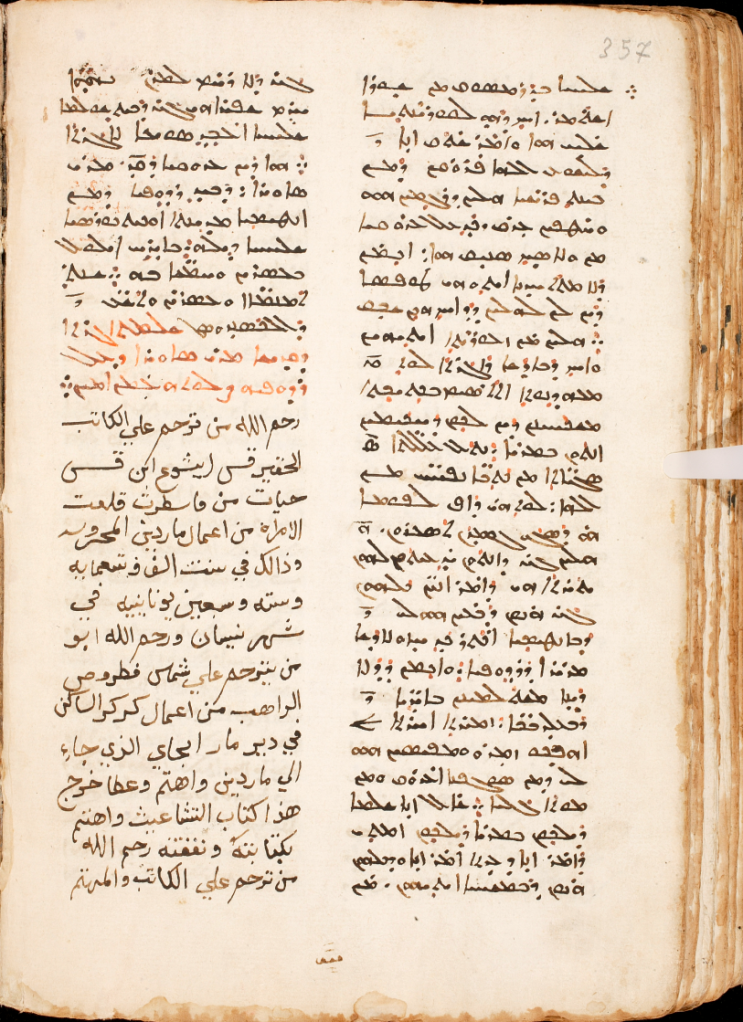Recently I wrote a post on translating into ancient languages. Lest any of my dear and faithful readers think me merely a theorist, here is a translation of a famous paragraph from Darwin’s On the Origin of Species Syriac’d, complete with vocalization. Comments on any aspect of the document are welcome!
Archive for February 2012
A little Darwin in Syriac 3 comments
Two Jerusalem manuscripts of Bar ˤEbrāyā’s philosophical œuvre Leave a comment
Resources on Old Nubian 3 comments
Several weeks ago I had HMML order some more books with Old Nubian texts and they arrived last week. Like the bulk of scholarly work on this language and its literature, these books are from the pen of Gerald M. Browne (1943-2004),[1] who worked in the classics department at the University of Illinois at Urbana-Champaign and is best known for his work on Old Nubian, as well as on Coptic.
 These most recent acquisitions at HMML are Beihefte from the series Beiträge zur Sudanforschung: Literary Texts in Old Nubian (1989) and The Old Nubian Miracle of Saint Menas (1994). Each volume includes the Old Nubian text with accompanying English translation and grammatical commentary; the former volume includes an Old Nubian-English glossary, and the latter a Greek-Old Nubian index and (bitonal) facsimile of the manuscript. Among other resources, HMML (or Saint John’s itself) has Browne’s Old Nubian Dictionary, CSCO 556 / Subs. 90 (Louvain, 1996) and Old Nubian Grammar (Munich, 2002).
These most recent acquisitions at HMML are Beihefte from the series Beiträge zur Sudanforschung: Literary Texts in Old Nubian (1989) and The Old Nubian Miracle of Saint Menas (1994). Each volume includes the Old Nubian text with accompanying English translation and grammatical commentary; the former volume includes an Old Nubian-English glossary, and the latter a Greek-Old Nubian index and (bitonal) facsimile of the manuscript. Among other resources, HMML (or Saint John’s itself) has Browne’s Old Nubian Dictionary, CSCO 556 / Subs. 90 (Louvain, 1996) and Old Nubian Grammar (Munich, 2002).
Old Nubian, of the Nilo-Saharan language family, was used in what is now Sudan and southern Egypt, and its descendant, Nobiin, is still spoken in the region today. It was written in an alphabet derived from Greek akin to Coptic, and, as in Coptic, there are a few extra letters, these from Coptic and Meroitic. Notable linguistic features include SOV (subject-object-verb) word order, the use of postpositions (as opposed to prepositions), the genitive noun coming first in genitive constructions, and adjectives following the nouns they modify. Browne produced a grammatical sketch in 1989 (Introduction to Old Nubian [Berlin]) that is rare these days, but his more complete Grammar referred to above is now the standard. His Dictionary was supplemented in 1997 by three appendices in a separate volume, also available at HMML: Old Nubian Dictionary: Appendices, CSCO 562 / Subs. 92 (Louvain, 1997).
Texts in Old Nubian survive from the eighth to the fifteenth centuries, with most from the tenth to the twelfth. Edited, these materials amount to under 100 pages of continuous text and include, among others, fragments from the Bible, some hagiography (the stories of St. Menas, St. George, and Epimachus), and the Nicene Canons. The longest continuous text is the Pseudo-Chrysostomian “Homily on the Venerable Cross”, the Greek original of which also survives. As is not surprising, there are connections between Old Nubian literature and that of Coptic and Ethiopian Christianity.
The study of Old Nubian is rather younger than that of most of its other eastern Christian neighbors. The British Egyptologist Francis Llewellyn Griffith (1862-1934) worked on the language in the early twentieth century: his Nubian Texts from the Christian Period (Berlin, 1913) contains some texts with English translation, a short description of the language, and a glossary. Werner Vycichl published some grammatical studies from 1956 to 1961 and, following Nubian excavations in the 1960s, F. Hintze did further work investigating the language. More recently, contemporaneous with Browne, the Russian scholar E.B. Smagina published some important works which, however, remain only in Russian.
There are, alas, no Old Nubian manuscripts available for research at HMML, but we can at least here study the language and its literature!
Note
[1] See a brief obituary here. A partial bibliography of his Nubian studies will be found in his Grammar referred to later in this post.
Another means of cursing 2 comments
A letter of Severos of Antioch 2 comments
In a 17th-century manuscript made up mostly of hagiographic material (discussed briefly here) from the Church of the Forty Martyrs (Mardin, no. 256), I have come across a letter attributed to Severos of Antioch (d. 538), a well known figure in Syriac literature, especially to those interested in the theological literature of christological controversy. The letter is titled, The Letter Sent by Mar Severos, Patriarch of Antioch, when He Was Banished by the Wicked Chalcedonians. Severos wrote in Greek, in which language but little of his work survives, while a very notable corpus consisting of homilies, hymns, letters, and theological works survives in Syriac translation. Most of the letters surviving in Syriac — themselves still but a small part of Severos’ whole epistolary oeuvre of more than 3800 (!) letters — were published and translated by Brooks in the early twentieth century (see the bibliography). Arthur Vööbus in 1975 brought attention to another letter, the very one I have just met in the Mardin manuscript, two pages of which I supply below; Vööbus also points to a few other manuscripts with the letter (cf. plate 11 at the end of the Vööbus Festschrift, ed. R.H. Fischer [Chicago, 1977], for one from Damascus) and a brief discussion of the manuscript settings in which the letter has been transmitted. I point out this letter (and Vööbus’ article), not only because, as far as I know, the letter still remains unpublished and because of its uniqueness and significance, but also because subsequent scholarship on Severos seems to have taken little notice of it. Finally, it should be noted that there is an Arabic (Garšūnī) version of the letter in the big manuscript from Saint Mark’s Monastery, Jerusalem, no. 199 (ff. 524v-526v acc. to the foliation with Syriac letters); a scan of a microfilm of this manuscript — also chiefly of hagiographic content — is available here as SMC 3-2 and 3-3, but full-color images of the manuscript and the rest of the Saint Mark’s collection (about 300 mss) will soon be accessible through HMML.
Bibliography
Pauline Allen and C.T.R. Hayward, Severus of Antioch (London and New York, 2004).
S.P. Brock, “Severos of Antioch,” in Sebastian Brock, Aaron Butts, George Kiraz, and Lucas Van Rompay, eds., Gorgias Encyclopedic Dictionary of the Syriac Heritage (Piscataway, 2011).
——–, “Some New Letters of the Patriarch Severos,” in Studia Patristica XII (Berlin, 1975), pp. 17-24.
E.W. Brooks, A Collection of Letters of Severus of Antioch, PO 12.2 (1915) and 14.1 (1920).
——–, The Sixth Book of the Select Letters of Severus Patriarch of Antioch in the Syriac Version of Athanasius of Nisibis, 2 vols. (London, 1902-1904).
CPG III, nos. 7022-7081, esp. 7070.11.
A. Vööbus, “Découverte d’une lettre de Sévère d’Antioche,” Revue des études byzantines 33 (1975): 295-298. (Available here.)
Héribert Rosweyde’s Vitae Patrum Leave a comment
 While studying William Wright’s description of a Syriac manuscript of saints’ lives (Add. 12174), I was impelled to see if Saint John’s had a copy of Héribert Rosweyde’s Vitae Patrum (Antwerp, 1615), and I was not disappointed. Upon request, my colleague kindly (on whose blog this post might fit well) brought the book up for my perusal, and here are a few photos of the pigskin-covered tome that show its size, fine typography, and maps.
While studying William Wright’s description of a Syriac manuscript of saints’ lives (Add. 12174), I was impelled to see if Saint John’s had a copy of Héribert Rosweyde’s Vitae Patrum (Antwerp, 1615), and I was not disappointed. Upon request, my colleague kindly (on whose blog this post might fit well) brought the book up for my perusal, and here are a few photos of the pigskin-covered tome that show its size, fine typography, and maps.
Héribert Rosweyde (1569-1629) stands at the beginning of the work of the Bollandists, the society dedicated to the scientific study of saints’ lives, work well represented by the voluminous and ponderous Acta Sanctorum, the journal Analecta Bollandiana, and the Subsidia Hagiographica series, the latter two publications continuing to this day. In the words of the Bollandist Hippolyte Delehaye, “L’oeurve capitale de Rosweyde, le Vitae Patrum, parut en 1615. C’est véritablement la pierre fondamentale des Acta Sanctorum” (L’oeuvre des Bollandistes à travers trois siècles, 1615-1915, 2d ed. [Brussels, 1959], p. 17; ET pp. 16-17),[1] and again,
Le recueil que Rosweyde entreprenait de publier est un des plus considérables, un des plus célèbres aussi, de toute la littérature hagiographique. C’est l’épopée des origines du monachisme en Égypte et en Syrie, une des plus grandioses et des plus attachantes qui soient.
Rosweyde’s initial researches into hagiography appeared as a much smaller book: Fasti sanctorum quorum Vitae in belgicis bibliothecis manuscriptae (Antwerp, 1607). Both this and the later book were printed at the famous Plantin press in Antwerp. The notable aspects of Rosweyde’s approach are its breadth — his plan was regarded as very ambitious (in particular to Cardinal Robert Bellarmine), and with good reason, since it is still being followed and carried out by his successors now four centuries later — and its close and faithful reliance on complete manuscript sources. He was not working on untilled soil, just ground that had not been most properly worked. As Delehaye says (pp. 14-15; ET pp. 12-13),
Voici comment Rosweyde entende recuellir et préparer les matériaux.
Pour les Vie déja imprimées, par example dans Lippomano et Surius, ne pas se contenter du texte de ces éditions, mais le collationner sur les manuscrits. On sait que dans les recueils précédents les pièces ont été souvent retouchées pour le style. L’autorité du document s’en trouve diminuée et le sens fréquemment altéré. Des prologues, des miracles, des passages obscurs ont été supprimés. It faut rétablir les textes dans leur intégrité.
Les pièces dont on ne trouve pas de manuscrits ne seront admises que si l’on a l’assurance qu’elles n’ont pas été retouchées. Quant aux Vies inédites, elles doivent être cherchées partout et insérées, à leur rang, parmi les autres. Les passages obscurs ne doivent pas être laissés sans explication ; ils seront éclaircis selon le programme des Illustrationes [in Vitas sanctorum].
Finally, while Rosweyde’s work does not yet fully exemplify the critical attitude of the following centuries, it is nevertheless a remarkable step forward from his predecessors, and one that is hardly without value even today.
Les méthodes minutieuses et précises appliquées de nos jours à l’établissement des textes n’étaient point créées à l’époque de Rosweyde, et il ne faut point chercher dans son édition les résultats qui supposent un travail de ce genre. Mais en dehors de cela, il a abordé tous les problèmes ; son intelligence claire les a nettement posés et résolus avec les ressources d’une érudition solide, sobre et élégante. Si l’on tient compte de l’étendue et de la variété des écrits qui forment le recueil, de l’imperfection des instruments de travail d’alors, des difficultés de l’exécution, on n’exagérera guère en qualifiant de chef-d’oeurve le Vitae Patrum de Rosweyde. (Delehaye, pp. 19-20; ET p. 20)
Rosweyde laid the groundwork with his plan, his purposeful approach to the texts, and his industry, but his death came before much of the task was realized. His work would continue in the hands of Jean Bollandus, from whom, of course, the society takes its name.
Note
[1] Yes, I know there is an English translation of Delehaye’s history of the first three centuries of the Bollandists, and that the first edition is available here, but I am too fond of French not to quote it. I have used the second French edition, but the first (1920) is available here. The corresponding pages in the first edition of the English translation are given for those who want or need them. In Latin, cf. also the proemium to Acta Sanctorum, Oct., vol. 7, pt. 1, available here (and, if you’re lucky, in your library: these magnificent volumes deserve to be read and touched directly.) More recent perspectives on Rosweyde and the subsequent work of the Bollandists will be found in R. Godding, B. Joassart, X. Lequeux, and F. De Vriendt, De Rosweyde aux Acta Sanctorum: La recherche hagiographique des Bollandistes à travers quatre siècles. Actes du Colloques international (Bruxelles, 5 octobre 2007) (Brussels, 2009).
Sindbad in Garšūnī 2 comments
The story of Sin(d)bad the Sailor, in Arabic Sindbād al-baḥrī, is known, at least nominally, in various incarnations (such as this 1958 film), but it was especially the French adaptation of The Thousand and One Nights (Alf layla wa-layla) by Antoine Galland, into which the story of Sindbad had been inserted, that first made the series of his seven voyages familiar in Europe. Recently, while looking over a Garšūnī manuscript from the Syriac Orthodox Archdiocese of Aleppo containing The Colloquy of Moses, a text that survives in a few languages and on which I have been collecting some evidence, followed by a short, as yet unidentified, religious text, I came to the next work, the beginning of which was missing. The first rubric I found, a few folios into this new text, was simply “The third story [ḥikāya]”, but upon reading a bit of it, it was immediately clear that the text was The Seven Voyages of Sindbad. I had no Arabic text to check it against, and I still do not have one, but the text here is most certainly the same collection known from European versions of The Thousand and One Nights. The text in the folio images below corresponds, for example, to vol. 6, pp. 37-38, of the first edition of Richard Burton’s version of the stories. The text in this manuscript, SOAA 124(m), goes from ff. 98r-165v, and brings the codex to an end. The beginning, as intimated above, is missing: the story is extant from partway into the second voyage to the end. Some folios are missing elsewhere in the text, in addition to the initial lacuna. There are at least two scribes for the manuscript, in this text and the rest of the book, neither of whom recorded a date, but it is not, I think, particularly young.
Unexpected finds such as this make cataloging and manuscript-rummaging delightful work, and they also serve, especially in their accumulation, to remind us of the multifarious quality of a people’s literary (and thus, cultural) corpus.
Bibliography
U. Marzolph, “Sindbād (the sailor),” in Encyclopaedia of Islam, vol. 9, pp. 638-640.
A picture in words 1 comment
While studying Armenian last night I came across a sentence that so picturesquely describes a scene from its narrative that I think it worthwhile to share here. The sentence is from The History of Armenia (Armenian title Buzandaran Patmut’iwnk’)[1] by P’awstos (Faustos) Buzand (Bk 4, ch. 5), and I met it among the reading passages from the Classical Armenian lessons that are part of the excellent Early Indo-European Online project at the University of Texas at Austin (also linked to on the left). The lines read:
Եւ իբրեւ լուաւ թագաւորն զայս ամենայն, զի մինչ դեռ խօսէրն արաջի նորա ՝ նա լուռ եւեթ կայր, ոտն զոտամբ արկեալ, արմուկն ի ծունգ եւ ձեռն ի ծնոտի ՝ նստաւ այնպէս, մինչեւ կատարեաց խօսեցաւ զամենայն զբանս իւր։
Internet typography of Armenian, like that of Arabic, being what it is — i.e. much too small in scale! — here’s a transliteration: ew ibrew luaw t’agaworn zays amenayn, zi minč’ deṙ xōsērn araǰi nora, na luṙ ewet’ kayr otn zotamb arkeal, armukn i cung ew jeṙn i cnōti, nstaw aynpēs, minč’ew katareac’ xōsec’aw zamenayn zbans iwr. In this passage, the Armenian king (Aršak II) has sent Nersēs, “the great catholicos of the Armenians” (mec kat’ołikos(n) Hayoc’; he is also called “archbishop of the Armenians” in this passage), to the emperor Valens (r. 364-378) — actually Constantius[2] — who sided in doctrine with Arians and was thus an almost natural enemy of Nersēs; the story goes that the son of Valens was ill, and Nersēs, having explained the accepted non-Arian doctrinal position, indicated that the emperor’s son would not be healed without his father’s acceptance of that position.[3] At this point comes the sentence given above in Armenian and English’d as follows:
And when the emperor heard all this — for while [Nersēs] was still speaking before him, [the emperor] remained silent, having put one foot around the other, his elbow on his knee, and his hand on his chin; he sat thus until [Nersēs] finished his whole speech — …
What a clear painting of the emperor’s posture! Nersēs’ words fall into the background, as the pace slows and the focus turns to the emperor and how he is taking in the full setting around him, both the condition of his son and the words and attitude of the august cleric before him. There is no description of his countenance, but there doesn’t need to be, for we can infer it with little trouble based on the close description of what he is doing with his body. Then suddenly, at the end of Nersēs’ words, following this careful and intent imperial pose, the solidity and stillness are shaken. The emperor “fell greatly into a rage” (mecapēs i c’asumn brdeal linēr t’agaworn), and, as in countless saints’ lives across traditions, theological dispute backed with state authority ends with someone in iron fetters: Nersēs, bound, is thrown into prison (tayr hraman, erkat’i kapanōk’ mecapēs — note this adverb again — kapel zsurb episkoposapetn Hayoc’ zNersēs, ew arkanel i p’iwłakē).
Promotion of a particular brand of theology is part and parcel of religious literature, as is, unfortunately, mistreatment in word and deed towards those of other factions, but this line highlighted here offers something encountered less frequently, something that qualifies as a small gem of literary description.
Notes
[1] Of the many studies (mostly in Armenian) and translations of the Buzandaran Patmut’iwnk’ (see R. Thomson, A Bibliography of Classical Armenian Literature to 1500 AD [Turnhout, 1995], 185-187), I only cite the following:
- N.G. Garsoïan, The Epic Histories Attributed to P’awstos Buzand (Buzandaran Patmut’iwnk’) (Cambridge, MA, 1989).
- Agop J. Hacikyan, et al., The Heritage of Armenian Literature, vol. 1 (Detroit, 2000), 183-212.
- P. Peeters, “Le début de la persécution de Sapor d’après Fauste de Byzance,” Révue des études arméniennes 1 (1920): 15-33. Reprinted in his Recherches d’histoire et de philologie orientales, vol. 1 (Brussels, 1951), 59-77.
- L. von Patrubany, “Die Geschichte Armeniens des Faustos Buzandaci,” Sprachwissenschaftliche Abhandlungen 2 (1900) 1-5, 17-23.
On this particular passage of P’awstos Buzand’s work, especially its historical difficulties, see especially N.G. Garsoïan, “‘Quidam Narseus’ — A Note on the Mission of St. Nersēs the Great,” in Armeniaca. Mélanges d’études arméniennes (Venice, 1969), 148-164. Reprinted at ch. V of her Armenia between Byzantium and the Sasanians (London, 1985).
[2] See Garsoïan, “A Note,” p. 151 with n. 12.
[3] This episode of a sick son of an emperor and a saint’s refusal to heal him is taken from the life of Basil: see Garsoïan, p. 152 with n. 13.












